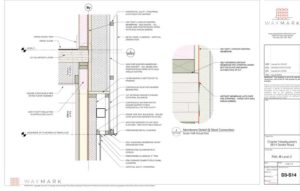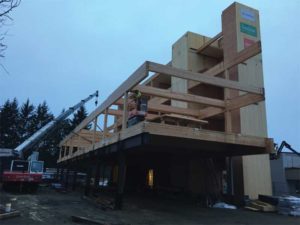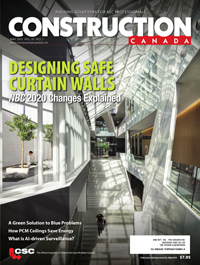Passive House goes to work

The availability of Passive House-certified HRV units is limited in Canada, and ones with large enough capacity to meet the ventilation requirements for commercial buildings are rarer. Four units of the largest available size have been installed in Charter’s headquarters. This was an acceptable compromise since the subdivision of the building into different zones allows for better control, and helps avoid over-ventilating areas with intermittent occupancy, especially the fourth-floor event space and hospitality suite.
Lessons learned
When applying Passive House design to a larger, more complex, and locally unique project, a collaborative approach facilitated an understanding of potential challenges, less conventional construction methods, and quality expectations among the construction team, before the design was even issued for build. Instead of viewing the high-performance goal as a burdensome requirement imposed on a bidding proponent potentially unfamiliar with Passive House fundamentals, it became a point of pride that was shared by all team members. This became critical to achieving a high-performance building.

On a similar note, co-ordination is critical not only during design, but also onsite. Quality training in high-performance building is available for consultants, and tradespersons can also learn some of the essential skills (e.g. how to properly install air barriers) effectively. However, there is no training for general contractors, as it requires changes in approach including sequencing, what to communicate to sub-trades, and other co-ordination issues.
The design team was focused on Passive House criteria throughout the design phase, and that attention seems to have paid off. There have been bumps on the road, but one of the telling lessons learned was energy performance is not the biggest issue. Instead, budget, scheduling, changes requested late, and other problems that can come up in any building project have been the cause of headaches during the construction of the Charter Telecom’s office facility.
Conclusion
This project has demonstrated the Passive House standard can provide value to private commercial building owners. The owner’s main motivation was not sustainability (although that was a factor) but the creation of a quality working environment for staff and upfront investment to achieve lower operating, maintenance, and life-cycle costs.
Regardless of the driving forces behind high-performance building projects, code changes and broader regulatory policies will demand the design-construction industry ramps up its capacity to constantly and cost effectively produce these types of builds. The only known way (without speculative technologies) to limit global warming to below 2 C (35 F) is to reduce demand for energy dramatically, and, in the author’s opinion, a switch to renewables cannot meet demand unless there is less of it. Achieving healthier, comfortable, and higher quality buildings with low-maintenance needs on the scale necessary to limit global warming to below 2 C requires Passive House levels of performance on all new buildings and retrofits.
The Charter building is a milestone in the industry’s road to net-zero energy ready performance. The project’s typology and scale sets it apart from other Passive House builds in the region. The author hopes this project will be a catalyst for high-performance builds to expand into the non-residential market. The success of this project proves massive improvement in energy performance is achievable in a commercial office building located on a challenging site and with builders who did not have previous experience in high-performance buildings.
![]() Graeme Verhulst, Architect AIBC, MRAIC, CPHD, is the co-founder of Waymark Architecture. As keen advocate for advanced building science and the need to move new and existing buildings toward net-zero and beyond, he was an early adopter of Passive House in Canada. He can be reached via e-mail at graeme@waymarkarchitecture.com.
Graeme Verhulst, Architect AIBC, MRAIC, CPHD, is the co-founder of Waymark Architecture. As keen advocate for advanced building science and the need to move new and existing buildings toward net-zero and beyond, he was an early adopter of Passive House in Canada. He can be reached via e-mail at graeme@waymarkarchitecture.com.


